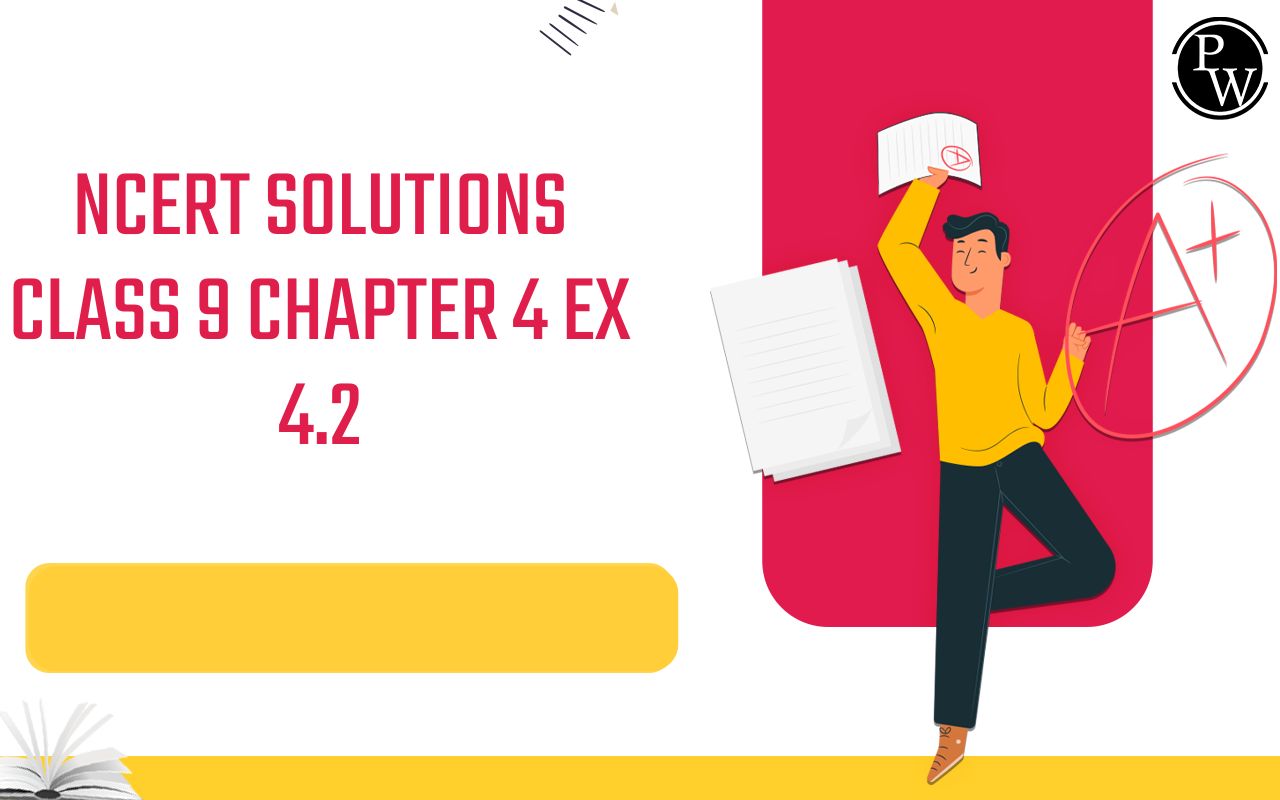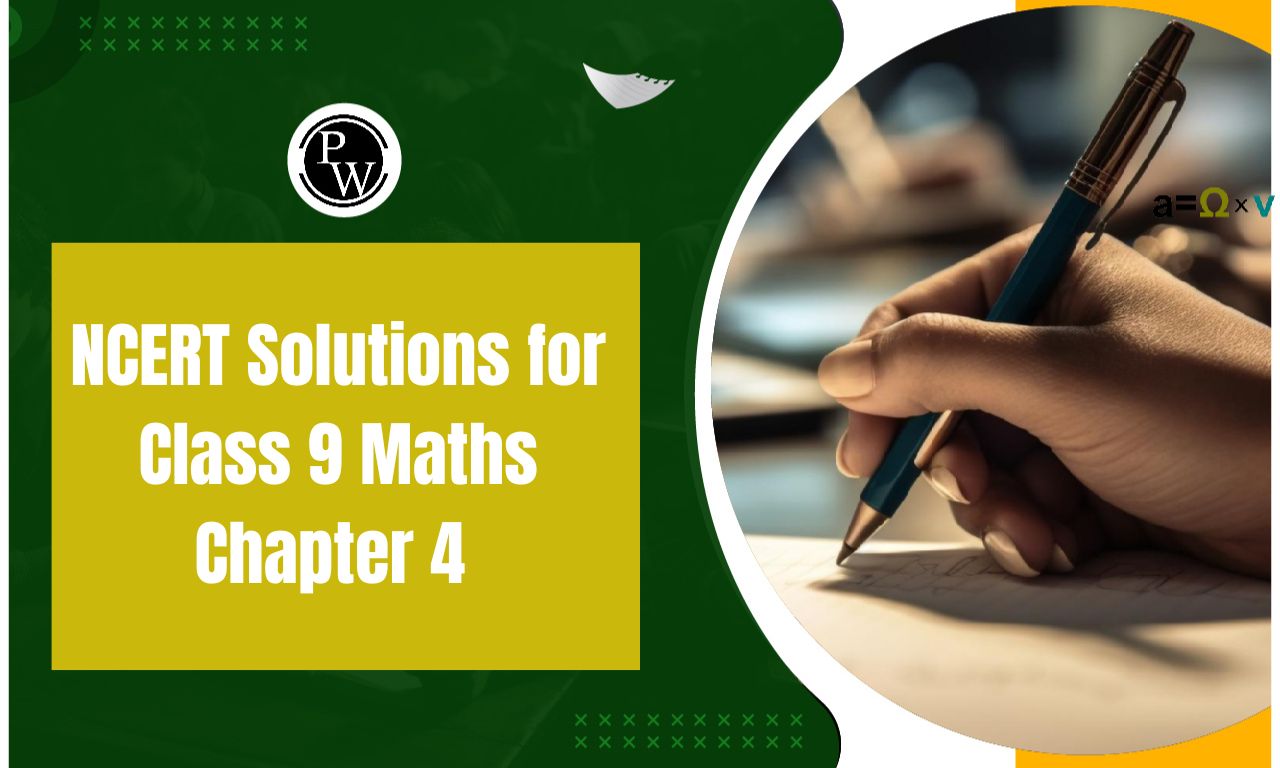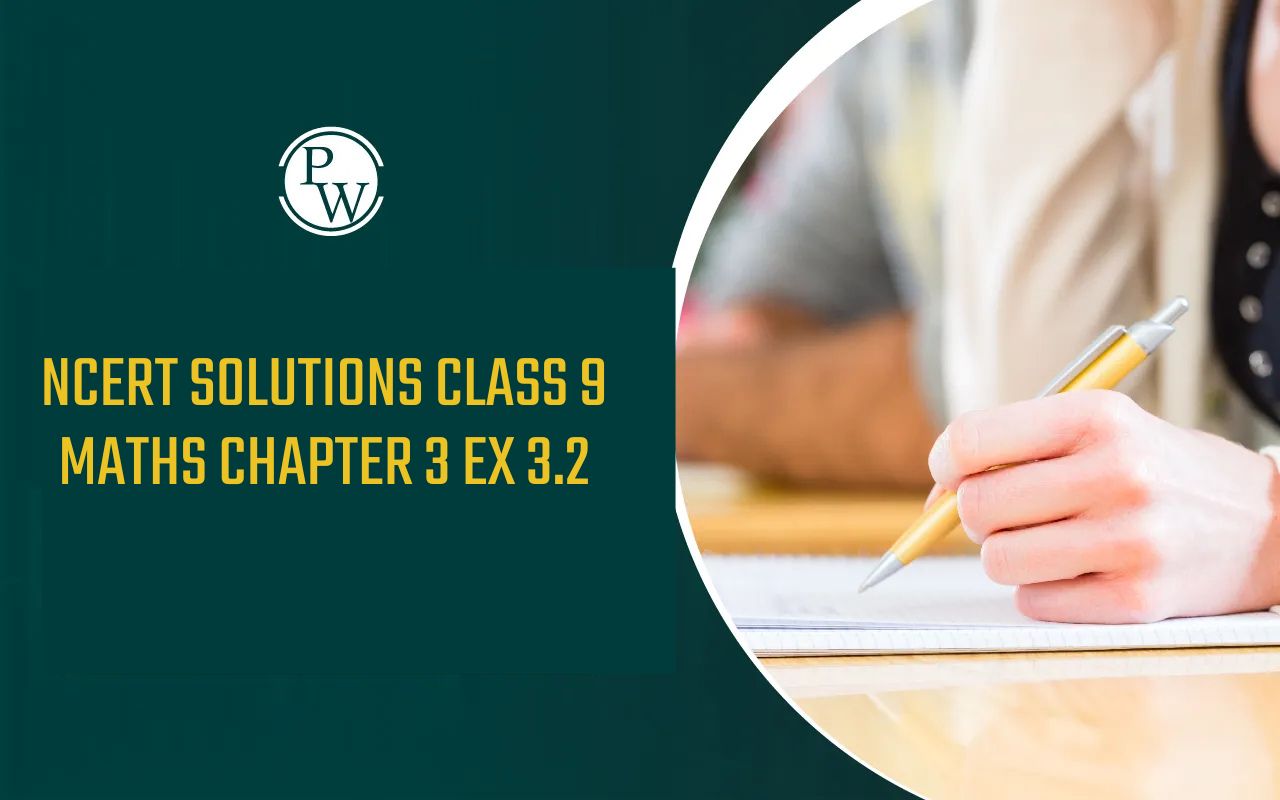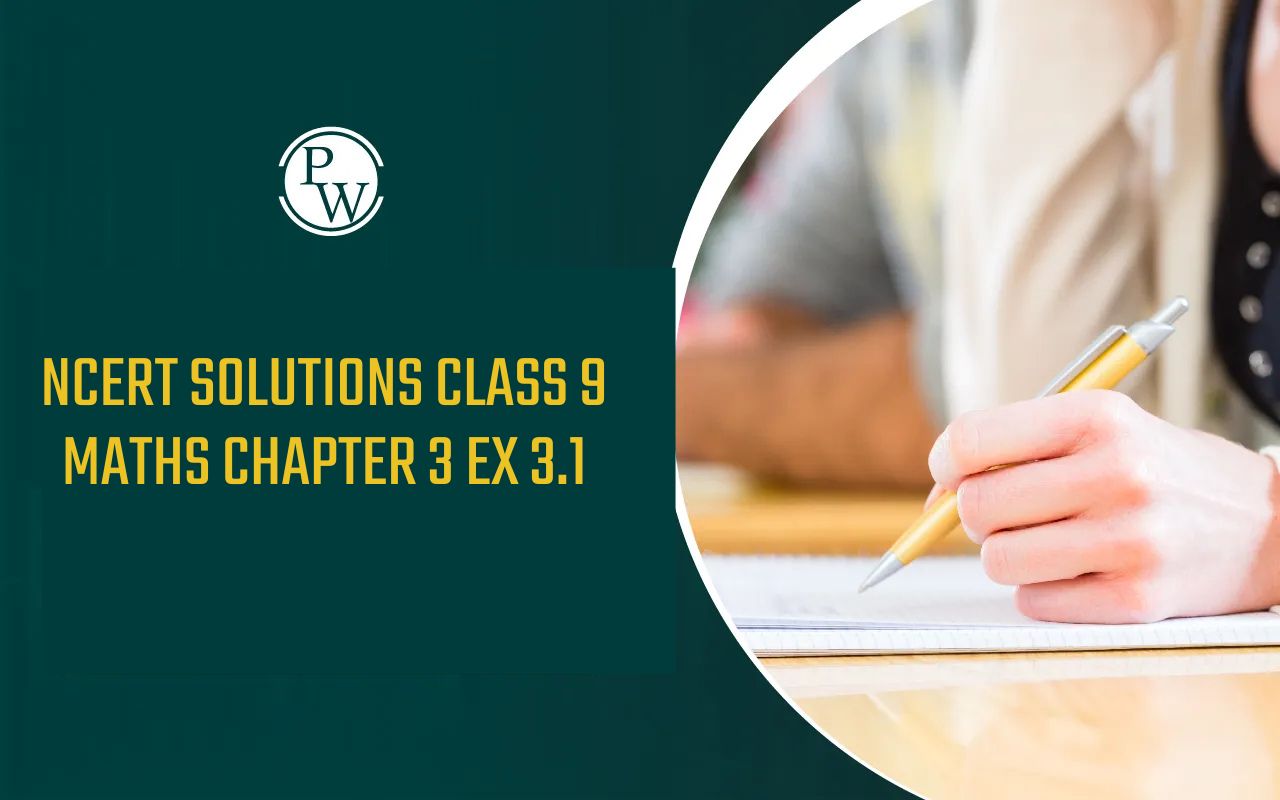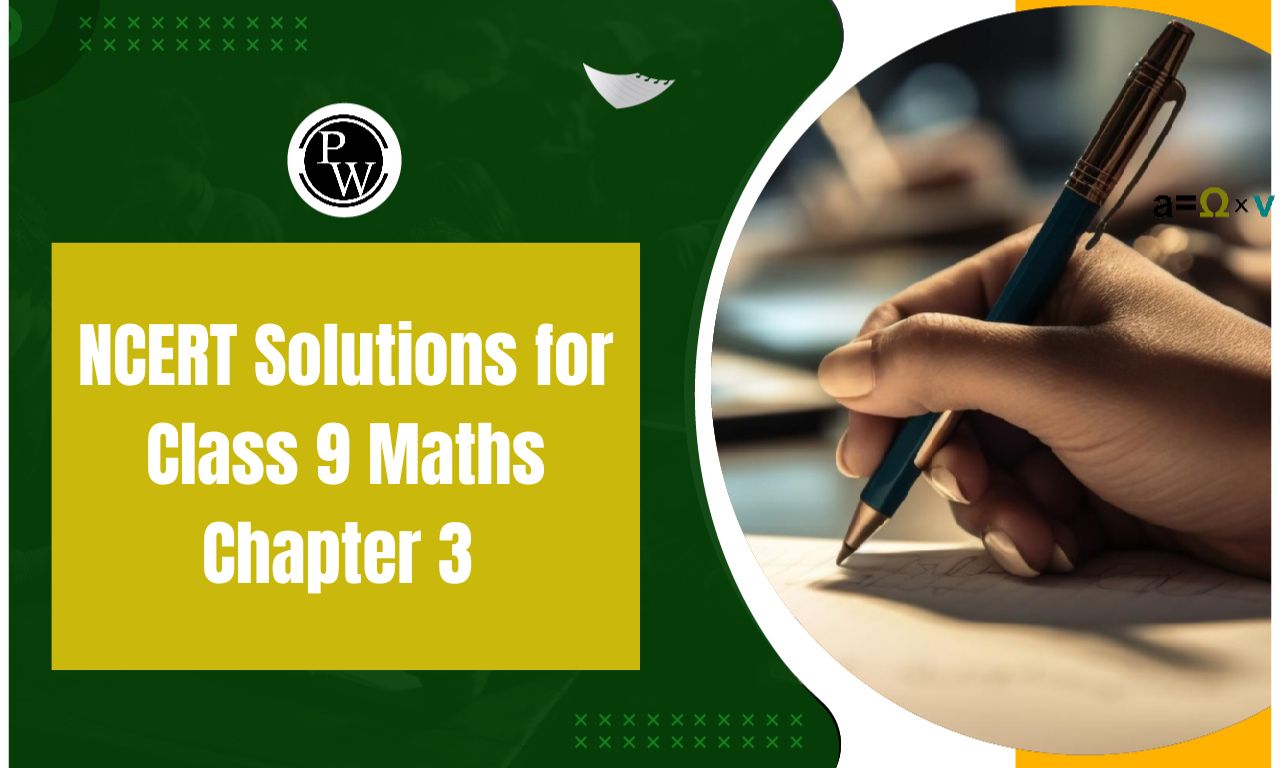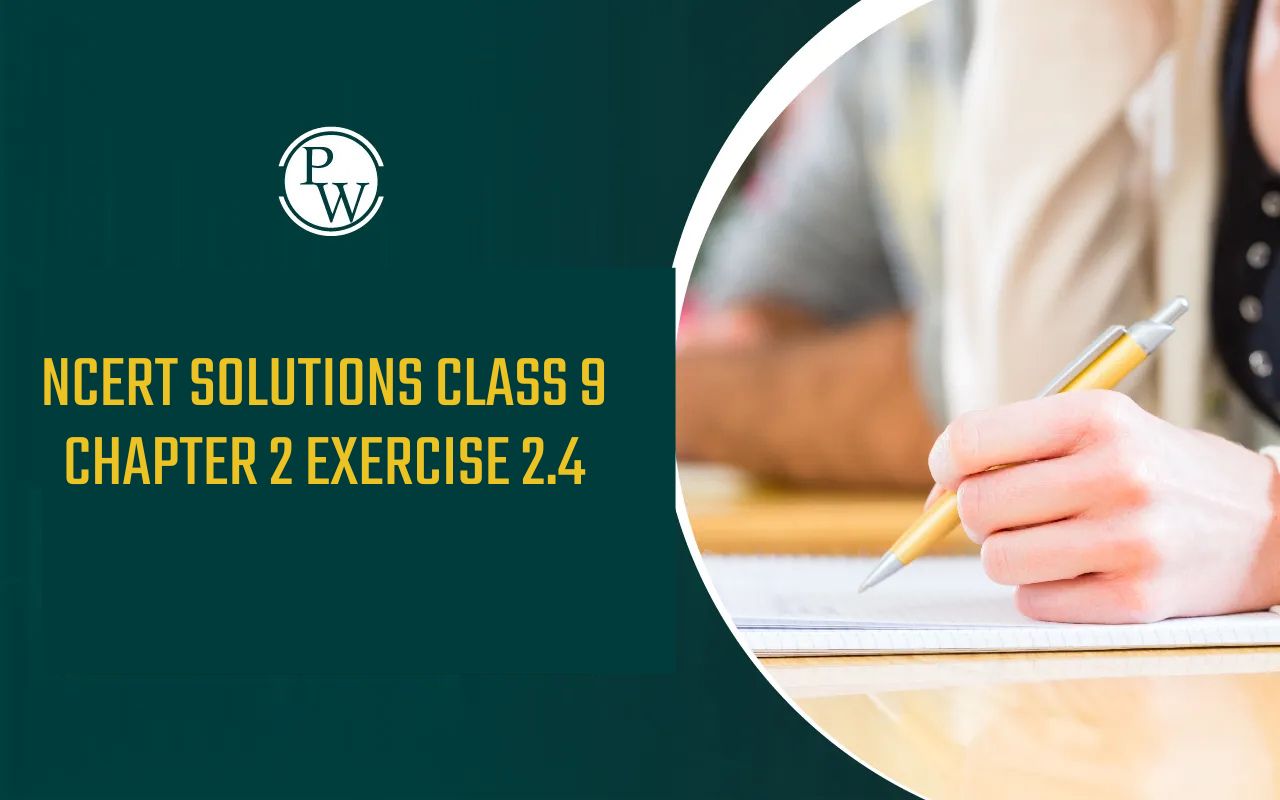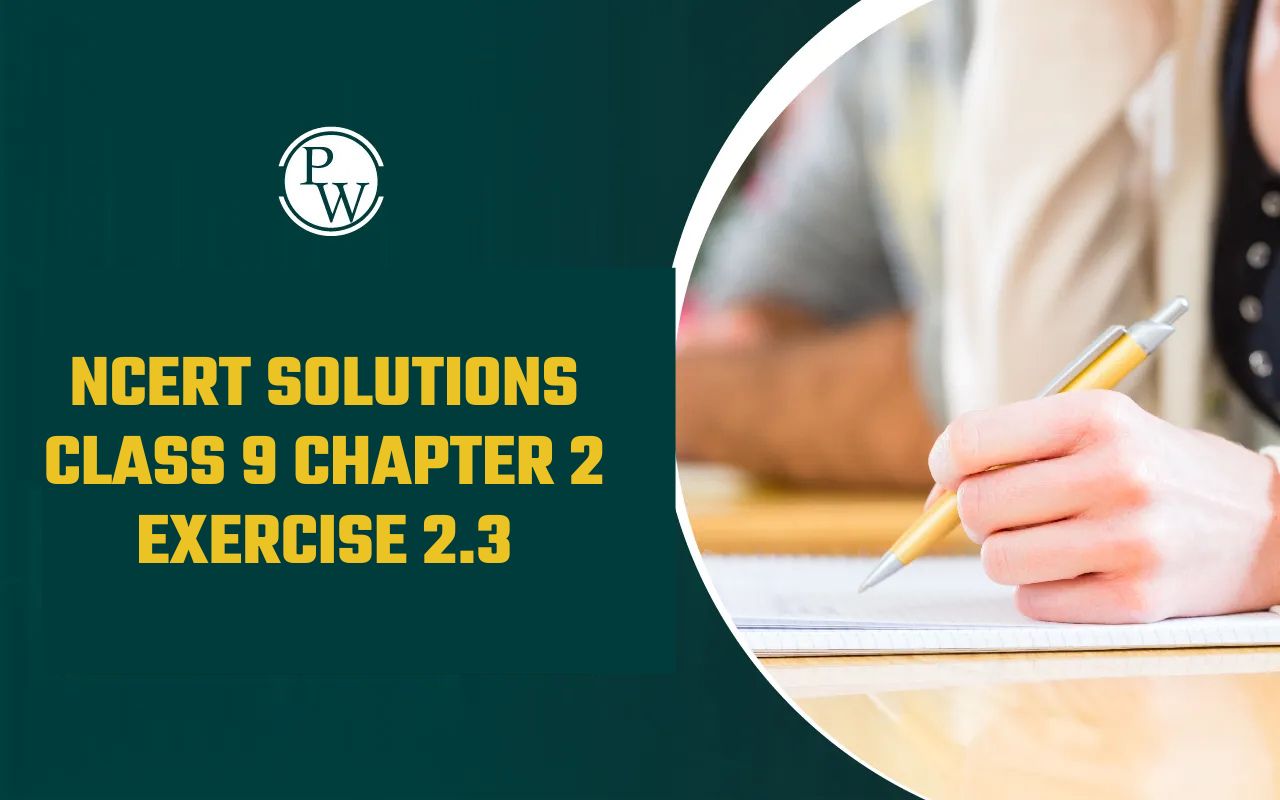
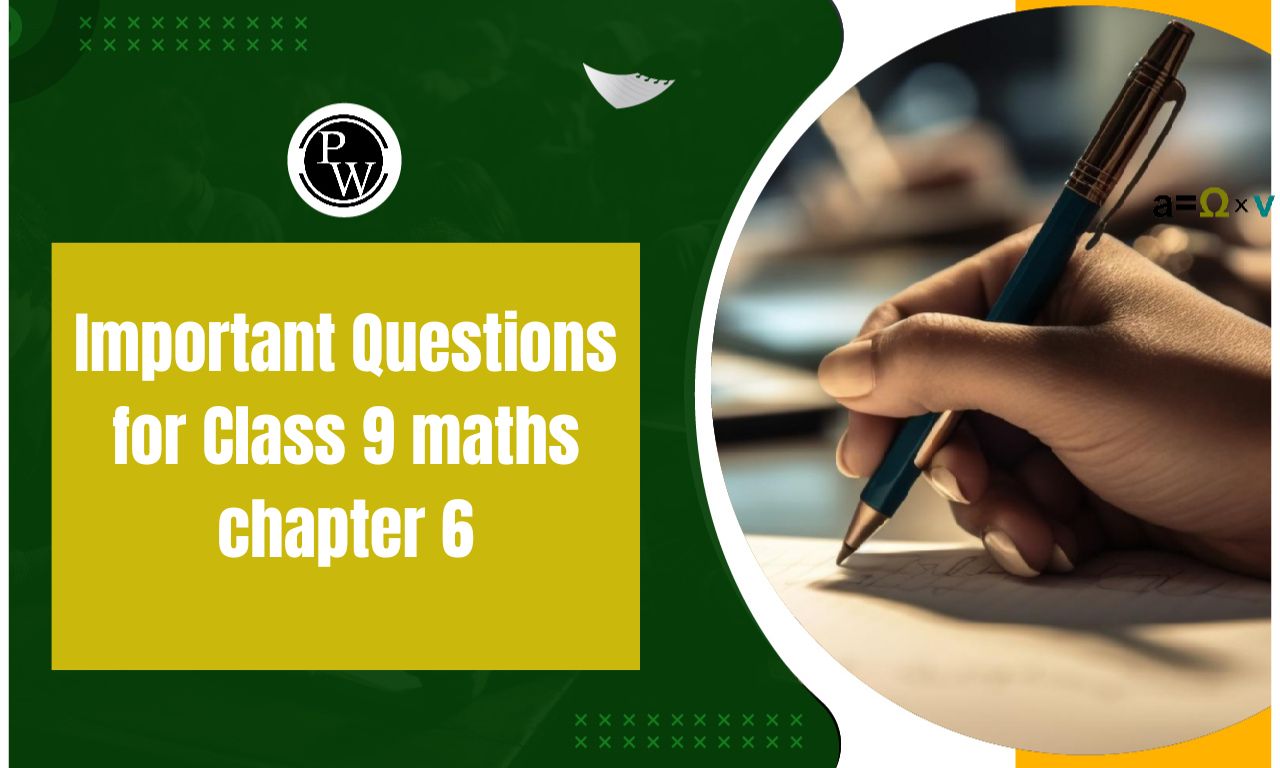
Important Questions for Class 9 Maths Chapter 6: Chapter 6 of Class 9 Maths, "Lines and Angles," focuses on the relationships between different types of angles formed by intersecting lines. Key concepts include complementary and supplementary angles, vertically opposite angles, and the properties of parallel lines cut by a transversal. Important questions often involve proving angle relationships, calculating unknown angles, and applying theorems related to parallel lines.
Students should be familiar with angle pairs, such as alternate interior, alternate exterior, and corresponding angles, as these are crucial for solving problems. Mastery of this chapter lays the foundation for understanding geometric concepts in higher classes.Important Questions for Class 9 Maths Chapter 6 Overview
Important Questions for Class 9 Maths Chapter 6 Lines and Angles covers essential concepts such as complementary and supplementary angles, vertically opposite angles, and the properties of parallel lines intersected by a transversal. Important questions from this chapter are vital for developing critical thinking and problem-solving skills, as they require students to apply geometric theorems and properties.Mastering these questions enhances students’ understanding of angle relationships, which is foundational for future geometry topics. Additionally, these concepts are frequently tested in exams, making proficiency in this chapter crucial for academic success and a solid groundwork for higher-level mathematics.
CBSE Important Questions for Class 9 Maths Chapter 6 PDF
In this, we have highlighted the importance of important questions from Class 9 Maths Chapter 6, "Lines and Angles," focusing on angle relationships and properties of parallel lines. Mastering these questions is crucial for building a strong foundation in geometry. Below, we have provided a PDF containing these essential questions to aid in your preparation and enhance your understanding of the topic.Important Questions for Class 9 Maths Chapter 6 PDF
Important Questions for Class 9 Maths Chapter 6 Lines and Angles
Below is the Important Questions for Class 9 Maths Chapter 6 Lines and Angles - Question 1: If one angle of the triangle is equal to the sum of the other two angles, then the triangle is (A) An equilateral triangle (B) An obtuse triangle (C) An isosceles triangle (D) A right triangle Solution 1: (D) A right triangle Explanation: We suppose the angles of △ABC be ∠A, ∠B and ∠C Given, ∠A= ∠B+∠C …(equation 1) But, in any △ABC, Using the angle sum property, we have, ∠A+∠B+∠C=180o …(equation 2) From equations (eq1) and (eq2), we get ∠A+∠A=180o ⇒2∠A=180o ⇒∠A=180o/2 = 90o ⇒∠A = 90o Thus, we get that the triangle is a right-angled triangle Question 2. The exterior angle of the triangle is 105°, and its two interior opposite angles are equal. Each of these equal angles is (A) 75° (B) 52 ½ o (C) 72 ½ o (D)37 ½ o Solution 2: (B) 52 ½o Explanation: As per the question, The exterior angle of the triangle will be = 105° We suppose the two interior opposite angles of the triangle = x We know that, The exterior angle of a triangle will be = the sum of interior opposite angles Thus, we have, 105° = x + x 2x = 105° x = 52.5° x = 52½ Question 3: The angles of the triangle are in the ratio 5 : 3: 7. The triangle is (A) An acute angled triangle (B) An isosceles triangle (C) A right triangle (D) An obtuse-angled of triangle Solution 3: (A) An acute angled triangle Explanation: As per the question, The angles of the triangle are in the ratio of 5 : 3: 7 Let the ratio 5:3:7 be 5x, 3x and 7x Using the angle sum property of the triangle, 5x + 3x +7x =180 15x=180 x=12 Putting the value of x, i.e., x = 12, in 5x, 3x and 7x we have, 5x = 5×12 = 60 3x = 3×12 = 36 7x = 7×12 = 84 As all the angles are less than 90, the triangle will be an acute-angled triangle. Question 4: In the given figure, if PQ || RS, then find the measure of angle m. Solution 4: Here, PQ || RS, PS is a transversal. ⇒ ∠PSR = ∠SPQ = 56° Also, ∠TRS + m + ∠TSR = 180° 14° + m + 56° = 180° ⇒ m = 180° – 14 – 56 = 110° Question 5: In Figure, the lines AB and CD intersect at the point O. If ∠AOC +∠BOE = 70° and ∠BOD = 40°, find ∠BOE and the reflex ∠COE. Solution 5: From the diagram, we have (∠AOC +∠BOE +∠COE) and (∠COE +∠BOD +∠BOE) forming a straight line. Then, ∠AOC+∠BOE +∠COE = ∠COE +∠BOD+∠BOE = 180° Now, by substituting the values of ∠AOC + ∠BOE = 70° and ∠BOD = 40° we have, ∠COE = 110° and ∠BOE = 30° So, reflex ∠COE = 360o – 110o = 250° Question 6: In the given figure, POQ is the line. The ray OR is the perpendicular to the line PQ. OS is another ray lying between the rays OP and OR. Prove that ∠ROS = 1 2 (∠QOS – ∠POS). Solution 6: Given that OR is perpendicular to PQ ⇒ ∠POR = ∠ROQ = 90° ∴ ∠POS + ∠ROS = 90° ⇒ ∠ROS = 90° – ∠POS Adding ∠ROS to both sides, we have ∠ROS + ∠ROS = (90° + ∠ROS) – ∠POS ⇒ 2∠ROS = ∠QOS – ∠POS ⇒ ∠ROS = 12 (∠QOS – ∠POS). Question 7: In Figure, the lines XY and MN intersect at the point O. If ∠POY = 90° and a: b = 2 : 3, find c. Solution 7: We know, the sum of the linear pair is always equal to 180° Thus, ∠POY +a +b = 180° Putting the value of ∠POY = 90° (given in the question), we have, a+b = 90° Now, given, a: b = 2 : 3, so, We suppose a be 2x, and b be 3x ∴ 2x+3x = 90° Solving this equation, we get 5x = 90° So, x = 18° ∴ a = 2×18° = 36° In the similar manner, b can be calculated, and the value will be b = 3×18° = 54° From the given diagram, b+c also forms a straight angle, so, b+c = 180° c+54° = 180° Therefore, c = 126° Question 8: In the Figure, ∠PQR = ∠PRQ, then prove that ∠PQS = ∠PRT. Solution 8: As ST is a straight line so, ∠PQS+∠PQR = 180° (since it is a linear pair) and ∠PRT+∠PRQ = 180° (since it is a linear pair) Now, ∠PQS + ∠PQR = ∠PRT+∠PRQ = 180° We know, ∠PQR =∠PRQ (as given in the question) ∠PQS = ∠PRT. (Hence proved). Question 9: In the Figure, if x+y = w+z, then prove that AOB is a line. Solution 9: To prove AOB is a straight line, we will first have to prove that x+y is a linear pair i.e. x+y = 180° We know, the angles around a point are 360° so, x+y+w+z = 360° In the question, it is given that, x+y = w+z So, (x+y)+(x+y) = 360° 2(x+y) = 360° ∴ (x+y) = 180° (Hence proved). Question 10: In Figure, POQ is a line. The ray OR is perpendicular to the line PQ. OS is another ray lying between the rays OP and OR. Prove that ∠ROS = ½ (∠QOS – ∠POS). Solution 10: Given that (OR ⊥ PQ) and ∠POQ = 180° Thus, ∠POS+∠ROS+∠ROQ = 180° Now, ∠POS+∠ROS = 180°- 90° (As ∠POR = ∠ROQ = 90°) ∴ ∠POS + ∠ROS = 90° Again, ∠QOS = ∠ROQ+∠ROS Given, ∠ROQ = 90°, ∴ ∠QOS = 90° +∠ROS Or, ∠QOS – ∠ROS = 90° As ∠POS + ∠ROS = 90° and ∠QOS – ∠ROS = 90°, we have ∠POS + ∠ROS = ∠QOS – ∠ROS 2 ∠ROS + ∠POS = ∠QOS Or, ∠ROS = ½ (∠QOS – ∠POS) (Hence proved). Question 11: In the figure, find the values of x and y and show that AB || CD. Solution 11: We know, a linear pair is equal to 180°. Thus, x+50° = 180° ∴ x = 130° We also know, vertically opposite angles are equal. Thus, y = 130° In the two parallel lines, the alternate interior angles are equal. Here, x = y = 130° This proves that the alternate interior angles are equal, and thus, AB || CD. Question 12: In the given figure, PQ || RS and EF || QS. If ∠PQS = 60°, then find the value of ∠RFE. Solution 12: Given PQ || RS Thus, ∠PQS + ∠QSR = 180° ⇒ 60° + ∠QSR = 180° ⇒ ∠QSR = 120° Now, EF || QS ⇒ ∠RFE = ∠QSR [corresponding ∠s] ⇒ ∠RFE = 120° Question 13: In the figure, if AB || CD, CD || EF and y : z = 3 : 7, find x. Solution 13: We know, AB || CD and CD||EF Since the angles on the same side of the transversal line sum up to 180°, x + y = 180° —–equation (i) Also, ∠O = z (Since corresponding angles) and, y +∠O = 180° (Since linear pair) So, y+z = 180° Now, let y = 3w and thus, z = 7w (As y : z = 3 : 7) Therefore, 3w+7w = 180° Or, 10 w = 180° Thus, w = 18° Now, y = 3×18° = 54° and, z = 7×18° = 126° Now, the angle x can be calculated from equation (i) x+y = 180° Or, x+54° = 180° ∴ x = 126° Question 14: In the figure, if AB || CD, EF ⊥ CD and ∠GED = 126°, find ∠AGE, ∠GEF and ∠FGE. Solution 14: As AB || CD, GE is a transversal. Given that ∠GED = 126° So, ∠GED = ∠AGE = 126° (Since they are alternate interior angles) And, ∠GED = ∠GEF +∠FED As EF⊥ CD, ∠FED = 90° ∴ ∠GED = ∠GEF + 90° Or, ∠GEF = 126° – 90° = 36° Again, ∠FGE +∠GED = 180° (Since transversal) Substituting the value of ∠GED = 126° we get, ∠FGE = 54° So, ∠AGE = 126° ∠GEF = 36° and ∠FGE = 54° Question 15: In figure, if AB || CD. If ∠ABR = 45° and ∠ROD = 105°, then find ∠ODC. Solution 15: Through the point O, we draw a line ‘l’ parallel to AB. ⇒ line I will also be parallel to CD, then ∠1 = 45°[alternate int. angles] ∠1 + ∠2 + 105° = 180° [straight angle] ∠2 = 180° – 105° – 45° ⇒ ∠2 = 30° Now, ∠ODC = ∠2 [alternate int. angles] = ∠ODC = 30° Question 16: In the figure, if PQ || ST, ∠PQR = 110° and ∠RST = 130°, find ∠QRS. [Hint: Draw a line parallel to ST through the point R.] Solution 16: First, we construct a line XY parallel to PQ. We know, the angles on the same side of the transversal are equal to 180°. Thus, ∠PQR+∠QRX = 180° Or, ∠QRX = 180°-110° ∴ ∠QRX = 70° In the similar manner, ∠RST +∠SRY = 180° Or, ∠SRY = 180°- 130° Therefore, ∠SRY = 50° Now, from the linear pairs on the line XY- ∠QRX+∠QRS+∠SRY = 180° Putting the values, we have, ∠QRS = 180° – 70° – 50° Hence, ∠QRS = 60° Question 17: In the figure, if AB || CD, ∠APQ = 50° and ∠PRD = 127°, find x and y. Solution 17: From the above diagram, ∠APQ = ∠PQR (Since Alternate interior angles) Now, substituting the value of ∠APQ = 50° and ∠PQR = x, we , x = 50° Also, ∠APR = ∠PRD (i.e., alternate interior angles) Or, ∠APR = 127° (Given ∠PRD = 127°) We know, ∠APR = ∠APQ+∠QPR Now, substituting the values of ∠QPR = y and ∠APR = 127° we get, 127° = 50°+ y Or, y = 77° Thus, the measure of x and y are as follows: x = 50° and y = 77° Question 18: In the given figure, p ll q, find the value of x. Solution 18: We extend the line p to meet RT at S. Such that MS || QT Now, in ARMS, we have ∠RMS = 180° – ∠PMR (Since linear pair] = 180° – 120° = 60° ∠RMS + ∠MSR + ∠SRM = 180° [i.e., by angle sum property of a ∆] ⇒ 60° + ∠MSR + 30o = 180° ⇒ MSR = 90° Now, PS || QT – ∠MSR = ∠RTQ ⇒ ∠RTQ = x = MSR = 90° (Since corresponding ∠s] Question 19: In the figure, PQ and RS are the two mirrors placed parallel to each other. An incident ray AB strikes the mirror PQ at B, the reflected ray moves along the path BC and strikes the mirror RS at C and again reflects back along CD. Prove that AB || CD. Solution 19: Firstly, we draw the two lines, BE and CF, such that BE ⊥ PQ and CF ⊥ RS. Now, since PQ || RS, So, BE || CF We know, The angle of incidence = Angle of reflection (By the law of reflection) So, ∠1 = ∠2 and ∠3 = ∠4 We also know, the alternate interior angles are equal. Here, BE ⊥ CF and the transversal line BC cuts them at points B and C. So, ∠2 = ∠3 (Since they are alternate interior angles) Here, ∠1 +∠2 = ∠3 +∠4 Or, ∠ABC = ∠DCB So, AB || CD (since alternate interior angles are equal) Question 20: In figure, the sides QP and RQ of ΔPQR are produced to the points S and T, respectively. If ∠SPR = 135° and ∠PQT = 110°, find ∠PRQ. Solution 20: Given that TQR is a straight line, and thus, the linear pairs (i.e. ∠TQP and ∠PQR) will add up to 180° So, ∠TQP +∠PQR = 180° Now, substituting the value of ∠TQP = 110° we have, ∠PQR = 70° We consider the ΔPQR, The side QP is extended to the point S, and so ∠SPR forms the exterior angle. Therefore, ∠SPR (∠SPR = 135°) is equal to the sum of the interior opposite angles. (By triangle property) Or, ∠PQR +∠PRQ = 135° Now, substituting the value of ∠PQR = 70° we get, ∠PRQ = 135°-70° Hence, ∠PRQ = 65°Benefits of Solving Important Questions for Class 9 Maths Chapter 6
Here are some benefits of solving Important Questions for Class 9 Maths Chapter 6, "Lines and Angles":Strengthens Understanding : Helps reinforce key concepts related to angles and their relationships.
Improves Problem-Solving Skills : Encourages critical thinking and application of geometric theorems.
Enhances Exam Preparation : Familiarizes students with commonly asked questions, boosting confidence for assessments.
Builds a Strong Foundation : Lays the groundwork for more advanced geometry topics in higher classes.
Encourages Practice : Regular practice of Important Questions for Class 9 Maths Chapter 6 helps in retaining concepts effectively.
Important Questions for Class 9 Maths Chapter 6 FAQs
What is the purpose of lines and angles?
What are the facts about lines and angles?
What is the relationship between lines and angles?
Who is the father of lines and angles?
Can two lines make an angle?

